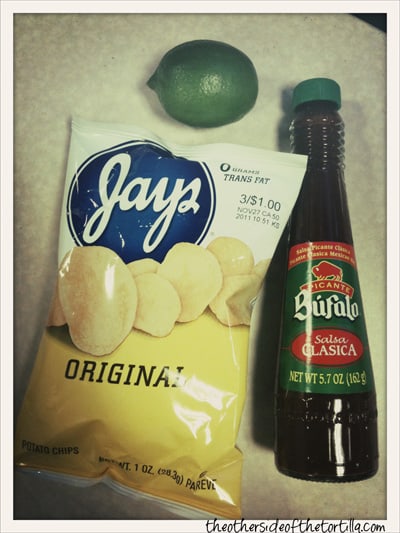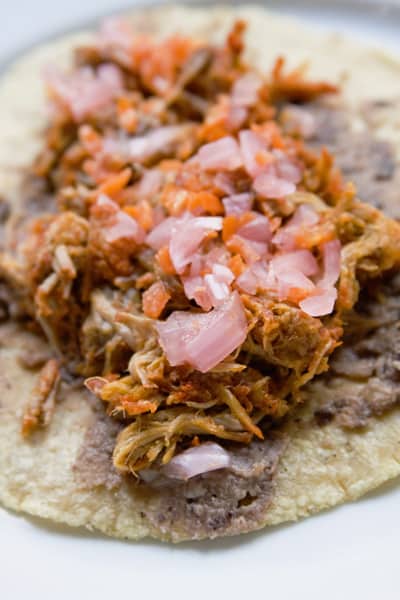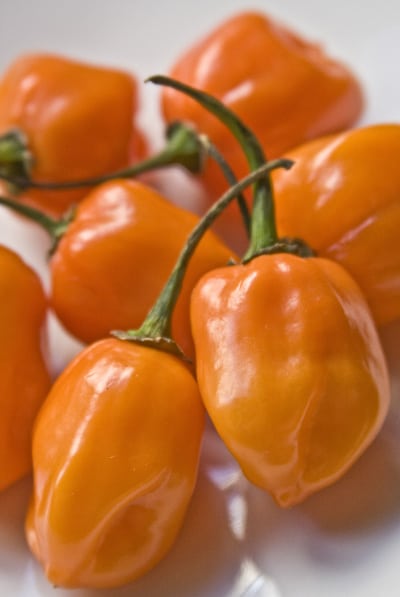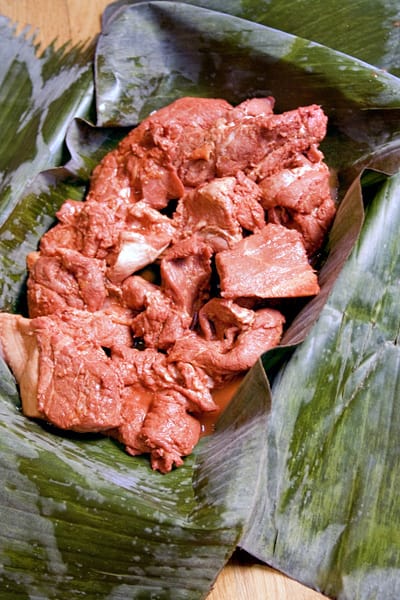On a recent trip to the grocery store, I found myself all alone in the hot sauce aisle…
Yes, my grocery store has a salsa aisle. It’s a little slice of heaven, no?
- What’s your favorite hot sauce?
2 · · 4 Comments
5 · · 3 Comments
 In many places in Mexico, you can find street vendors with little carts, selling antojitos, or snacks.
In many places in Mexico, you can find street vendors with little carts, selling antojitos, or snacks.
Usually, the standard offerings include chicharrones (pork rinds), chicharrones de harina (a fried, puffed wheat snack that looks orange) or papitas (potato chips).
Served in a little plastic bag with a squeeze of lime juice and your choice of salsa, it’s a great snack whether you’re on the go or just want to take a leisurely stroll through the park.
I like to keep a little bag of potato chips in my desk at work so I can make a quick afternoon snack—the only thing I need to remember to bring is a lime and a small bottle of salsa.
It’s a very simple and typical Mexican snack. You can choose whatever kind of salsa you like; spicy, medium, mild or even a salsa like chamoy, which is a sweet and spicy mixture usually made with chile powder and a salted fruit brine. It’s up to you!
I like to use the salsa pictured here, salsa clasica de Búfalo (but don’t be fooled; it’s not anything like buffalo sauce you’re used to seeing in the U.S.). It’s a slightly spicy and vinegary red salsa.
All you have to do to make your own is open the bag (be careful not to tear it), squeeze half a lime (or more if you like) inside the bag and then pour as much salsa in the bag as you like. Close the bag up and shake it so the salsa and lime juice distribute somewhat evenly and then just open the bag up and enjoy. ¿Que rico, no?
4 · · 15 Comments
I’ve always been fascinated by the different salsas served alongside my meal at any taquería. I ate all three of these (rojo con chile de árbol; verde con chile serrano y aguacate; cebolla roja con habanero) at my favorite taquería in Chicago, La Lagartija, this past weekend. They were just too pretty to not take a picture! One of the things I love about eating at taquerías is that each one has different salsas, and often the salsas are just as important as what goes in the taco.
4 · · 4 Comments
In case you missed it last week… check out our salsa de tres chiles on the Kenmore Genius Blog – the ultimate fresh, homemade dip for your tortilla chip! Warning: you may never be able to eat crappy restaurant “salsa” ever again after tasting this stuff. You know what I’m talking about – that runny, watery, often bland mess of tomatoes, onion and jalapeños they serve at chain restaurants. You’ll have to visit the Genius Blog for the full recipe with instructions, but here’s a sneak peek of the video:
[youtube]http://www.youtube.com/watch?v=qjYHU9woZ1s[/youtube]
12 · · 2 Comments

Earlier this summer, I found myself searching every ethnic food aisle and every Mexican grocery store in Chicago for Chata-brand canned Cochinita Pibil. Having had it before, I knew it wasn’t as good as the real thing but I was yearning for that delicious achiote-flavored pork. Sadly, it was nowhere to be found. In a moment of desperation, I even searched the internet to see if I could order it from somewhere—finding out I was going to have to pay nearly $10 for a 14-ounce can, plus shipping.
All I could think about was the last time I’d eaten cochinita pibil in Mexico. After a big Christmas celebration with our extended family in Mexico City, we took a trip to Cuernavaca to ring in the new year with my husband’s parents and sister. We spent our vacation playing Mexico City Monopoly (with properties like Xochimilco and Chapultepec instead of Park Place and Broadway) and endless hours of domino. Laughter and shouts of “tramposo!” could be heard any time it was suspected that José was cheating…which was often, because he always likes to win.
On our way back to Mexico City, we stopped at a Yucatecan restaurant called El Faisán, where my suegros often visit after spending a weekend with friends in Cuernavaca. It was the first time both José and I had been there.
I know if El Faisán wasn’t as authentic as anything you’d eat in Mérida, my family wouldn’t eat there. They suggested I try the queso relleno which had a picadillo-style mixture incorporated into the cheese; it’s a favorite of one of our tias. My cuñada ordered sopa de lima and shared it with me. But what pleased my palate the most was an order of three little tacos de cochinita pibil. In fact, we ended up asking for three orders, and there was a mad scramble to get more than one little taco each. Paired with a tall, ice-cold glass of horchata to drink (another one of my favorite things), I was in little piggy heaven.
José was skeptical when I ambitiously said I was going to make cochinita. “In a regular oven?” he said, “it’s gonna be yucky.” In the Mayan language, “pib” means an underground pit for cooking, and that’s the traditional way to make cochinita pibil. Obviously that would be difficult to accomplish living on the sixth floor of a condo building in downtown Chicago, where we have no backyard. But when all was said and done and he tasted his first little taco, he gave me his standard stamp of approval—two thumbs up—and his blessing to make it again.

RECETA:
SALSA DE HABANERO Y CEBOLLA
Roast habaneros in a skillet on medium heat until they start to get a few dark spots. Cut top off the pepper and discard stem. Finely dice the habaneros.
Mix the diced habaneros with the chopped onion in a bowl (or directly in the container you intend to store the salsa in, preferably in a glass jar). Pour juices over the habaneros and onions and then add the vinegar. Toss lightly to moisten and refrigerate for at least 4 hours before serving. Keeps refrigerated for about 5 days.
COCHINITA PIBIL
Marinade:

Cut achiote paste (comes in a block) into small chunks. Put into food processor with orange and lime juices to break up the paste and fully incorporate into the juice. Add the garlic, salt & pepper to the juice.
Pour into a gallon-sized Ziploc bag and add the chunks of pork. Remove air and seal the bag. Place the sealed bag in a large bowl and refrigerate overnight (about 12 hours).
In the morning, remove the meat from the juice and reserve the juice. You can put the meat and the juice back into the refrigerator until you’re ready to start cooking.
To prepare the banana leaves, turn your stove burners on low heat and place the leaves over the flames. You need to heat the leaves enough so they are pliable, but you don’t want them to cook and turn brown. The leaves will turn a brighter green when they’re heated through.
Heat the oven to 325 degrees.

In a roasting pan, place the banana leaves one over the other like a cross. Transfer the meat directly into the pan on top of the banana leaves. Pour about half of the reserved juice over the meat—the juice will help steam the meat so it becomes very tender. Gently fold the banana leaves over the meat, being careful not to rip them but so that the meat is completely enclosed within the banana leaves. Cover the roasting pan tightly with two pieces of foil. It’s important that steam won’t escape, so make sure the foil is really secure.
Place on the middle rack of the oven, once it reaches 325 degrees. Cook for about 2 ½ hours, or until meat is tender enough to shred gently with a fork.
Shred all the meat.
The meat can be served as a main dish itself, with side dishes such as fried plantains, black beans or rice, and as tacos or on panuchos (smaller, fried tortillas, with refried black beans in the middle). If you’re going to make them as tacos, spread refried black beans on the tortilla and then place the meat on top of the beans. Garnish with salsa de habanero y cebolla.
Yields 4 servings (3 tacos each).